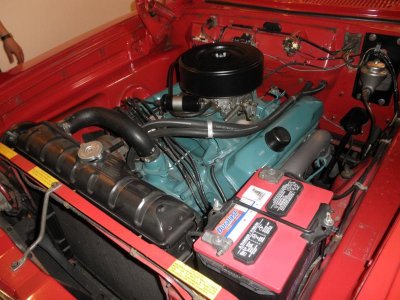62 Dart Convertible
Well-Known Member
Well I finally pulled out my engine (1962 Chrysler 300H 413 wedge) and have it all stripped down, and found two problems.:icon_shaking:
Problem 1. Previous engine builder:jerk:mixed up upper and lower no 5 main bearing shells, so no 5 main and no 7 & 8 big ends were not getting oil supply. These bearings were toasted, yet surprisingly, the crank looks OK. I haven't fully miked it up yet but visually the (already .020 under) journals look no worse than any other so I'm hoping I dodged a bullet here. Not a big problem either way...
Problem 2. Scratched off the carbon on pistons and found part no L2184 STD. Scoured internet and found these are std size crowned 11:1 pistons for a 426 wedge (with an intended bore size of 4.25"). I measured my bore and found it taken out to 4.2475" (which is 0.060" over std 4.1875"). So it seems these pistons are .0025" tighter in the bore than they are designed for.
The pistons and bore are still clean and tidy with surprisingly very little scuffing.
I am after some advice on what folks think I should do wrt problem 2.
Should I leave it as is and let sleeping dogs lie as it seems to working OK, OR have the block honed the extra .0025" and get the piston/bore clearance right? (I know 11:1 is pretty high, but it seemed to run OK on Premium 98 fuel.)
Problem 1. Previous engine builder:jerk:mixed up upper and lower no 5 main bearing shells, so no 5 main and no 7 & 8 big ends were not getting oil supply. These bearings were toasted, yet surprisingly, the crank looks OK. I haven't fully miked it up yet but visually the (already .020 under) journals look no worse than any other so I'm hoping I dodged a bullet here. Not a big problem either way...
Problem 2. Scratched off the carbon on pistons and found part no L2184 STD. Scoured internet and found these are std size crowned 11:1 pistons for a 426 wedge (with an intended bore size of 4.25"). I measured my bore and found it taken out to 4.2475" (which is 0.060" over std 4.1875"). So it seems these pistons are .0025" tighter in the bore than they are designed for.
The pistons and bore are still clean and tidy with surprisingly very little scuffing.
I am after some advice on what folks think I should do wrt problem 2.
Should I leave it as is and let sleeping dogs lie as it seems to working OK, OR have the block honed the extra .0025" and get the piston/bore clearance right? (I know 11:1 is pretty high, but it seemed to run OK on Premium 98 fuel.)

















